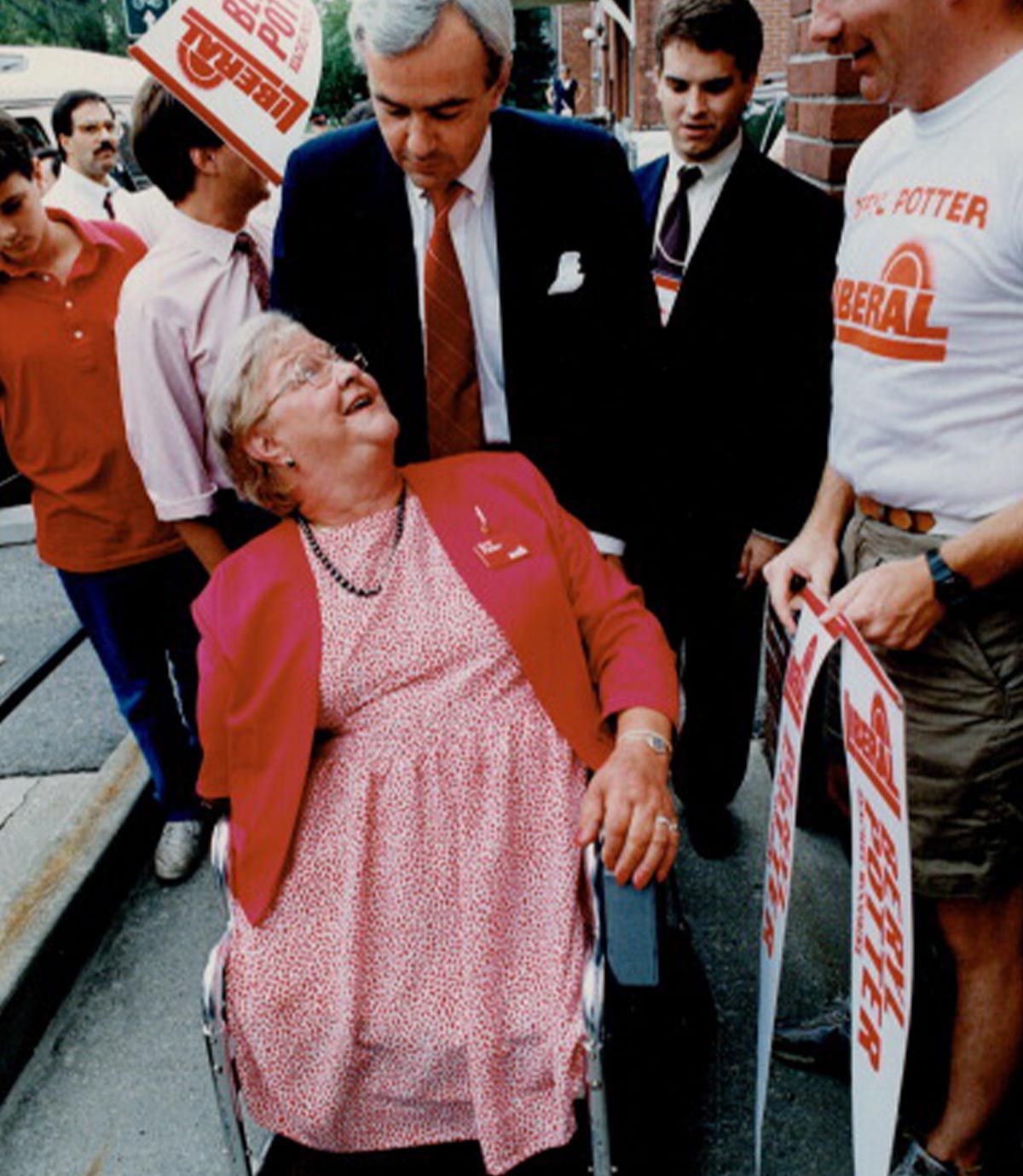For forty years of her life, Beryl Potter navigated the world as a relatively healthy, able-bodied person. She never struggled to find an accessible entrance or washroom. People did not stare at her as she went down the street. No one ever offered unsolicited prayers. She never had to field awkward questions from strangers about her body. She never felt the need to put at ease others who were uncomfortable in her presence. She never had to endure the patronizing tone of those who questioned her comprehension of what was being said to her. It was as if she now encountered the world for the first time, venturing out as a middle-aged triple amputee wheelchair user with a visual impairment.
Previously unseen barriers lurked around every corner. Sidewalks without curb cuts, doors without automatic buttons, inaccessible washrooms, and a lack of elevators. Access to restaurants, cafes, grocery stores, offices, and other public amenities each came with their own set of complications that needed to be navigated. Most buses and subways were out of reach, and paratransit services were virtually nonexistent in early 1970s Toronto. Then there were the social attitudes. Some people tried to be helpful, others would cross the street as if she were contagious. Those who did not know what to think would simply gawk, studying her as if she were an unusual art installation sprung to life.
In Scarborough, Beryl befriended her neighbours and regularly trekked to the newly constructed Scarborough Town Centre. Opened in 1973, the large, Y-shaped mall housed department stores, a grocery mart, and an array of retail stores. In the early 1970s, suburban shopping malls offered wheelchair users and others with mobility challenges a relatively barrier-free oasis in a sea of inaccessible streets and public spaces. Beryl soon developed a new circle of friends that included mothers of disabled children, teens, adults, and seniors living with cerebral palsy, brain injury, intellectual disabilities, spinal cord injuries, epilepsy, polio survivors, and members of the deaf community.
The reality of widespread inaccessibility in Canada did not happen by accident. Canada, like many Western nations, has a long history of confinement, oppression, and segregation of people with disabilities. During Canada’s colonial past, people with physical disabilities and mental illness were often stigmatized, kept separate from the rest of the community, and incarcerated by medical and religious institutions. Canadian officials imported old-world attitudes and models of care built on fear, ignorance, and condescension. Residential hospitals were established outside major metropolitan centres where people with disabilities were deposited into the care of doctors, their needs deemed impossible to handle by ill-equipped parents and family. In these facilities, often located hundreds of miles away from their local communities, children born with congenital disabilities, physical deformities, and intellectual disabilities resided alongside youth, adults, and seniors living with mental illnesses and physical impairments. Many spent their entire lives behind walls and locked doors. Houses of industry and sheltered workshops were set up to extract their labour for token wages, often disguised as occupational therapy or job training schemes. To prevent the unwanted expansion of the disabled population, many inmates were sterilized by doctors upholding the fanaticism of the eugenics movement, and immigrants were screened for signs of disability to bar those considered a burden on society.
Following the Second World War, attitudes toward persons with disabilities shifted markedly thanks in large part to veterans’ groups, community advocates, and parents of disabled children who organized themselves and lobbied to change the social and economic displacement of people with disabilities from mainstream society. Advocates established service agencies to make it easier for people with disabilities to leave institutions and lead fuller lives in the community. Rehabilitation hospitals, such as Lyndhurst Lodge in Toronto, returned people home in partnership with agencies, such as War Amps and the Canadian Paraplegic Association, to provide a level of support that did not otherwise exist in the community.
Parents of children born during the polio epidemic of the 1950s joined parents of children with intellectual disabilities in reframing permanent institutionalization as a problem rather than a solution. Extensive fundraising campaigns supported the development of community-run programs, including services of the Ontario March of Dimes and Easter Seals. These agencies pressured policy makers to shift public resources away from segregated facilities to support innovative community-based alternatives.
Beryl’s transition to her new life coincidentally overlapped with a new phase of disability activism. In the early 1970s, a wave of social activism was led by people with disabilities who asserted their human, civil, and consumer rights, with the goal of building a new social paradigm and legal system that would empower people with disabilities. Disability rights activists rejected the paternalism of many organizations led primarily by able-bodied people that, they argued, stood in the way of full independence for people with disabilities. They argued people with disabilities had rights as consumers to control their own services and resented how these organizations consumed the bulk of public funding and largely controlled the communication about the needs of the disability community to government and the wider public. Inspired by developments in the US and UK, disability rights groups started popping up across Canada, and some formed allegiances through the Coalition of Provincial Organizations of the Handicapped, later Council of Canadians with Disabilities.
In Toronto, Beryl watched as a group of professionals, family advocates, and disability rights activists demanded newly elected populist mayor David Crombie work with reformers and consumer activists to create a special task force to investigate ways to improve the level of accessibility across the city. As a prominent member of the reform movement, Crombie hoped to set an example to the larger Metropolitan Toronto area and the rest of the country on the matter of accessibility. By 1970, Toronto City Council endorsed a policy to ramp thousands of sidewalks and intersections across the city, and in 1973, the Metropolitan Toronto Social Services and Housing Committee began work on a public paratransit system. Wheel-Trans, as it was called, started in 1975 with the registration of 2,000 users. It had limited weekday operating hours, prioritizing essential trips to work, school, and medical appointments. By 1977, 1,000 sidewalks had been made accessible in the city of Toronto in high pedestrian traffic corridors and downtown transit hubs.
Beryl was inspired by these developments, especially the concept that people with disabilities did not have to accept the way things were and could challenge the conditions that excluded them from participation in mainstream life. She drew a direct line between the lack of accessibility and the isolation of people she met in hospital, in rehabilitation programs, and at the mall where she commiserated with them and heard their stories. She decided she needed to do something to help. The inspiring words of the good Reverend Bob Rumball rang in her ears. “The big guy up there did this to me for a reason. He’s got a plan,” she reminded herself. Maybe advocating for others was the plan.
One issue that continually topped the list of problems for people with disabilities was the lack of accessible transportation. Subways and buses were rarely fully accessible, and Beryl was one of many people with disabilities reliant on a small fleet of accessible taxis. There were never enough taxis to meet demand, and the cost was often prohibitive to people who lived on a fixed income. She wondered what was the point of encouraging people to get out and participate in the community if they had no access to reliable transportation? In 1976, Beryl joined a growing chorus of voices across Metro Toronto advocating for better public paratransit services. Wheel-Trans had commenced operations the previous year, but the Toronto Transit Commission contracted the service out to a private company called All-Way Transportation, a service that quickly proved woefully inadequate, especially in the suburban boroughs of Scarborough. Beryl relied on Wheel-Trans to get around town and was disappointed with its many shortcomings. She argued that a larger fleet of Wheel-Trans vans and buses was needed, with a commitment to establish quality standards for paratransit riders across the city. She formed a coalition of disabled people dedicated to working with the TTC, local officials, and the Ontario government. But progress was slow, and firm commitments were not materializing.
Beryl learned early on that building affordable and accessible transportation systems would be critical to the successful integration of people with disabilities. “I remember, before my accident, I took transportation for granted,” she said. “I was completely mobile, and if I wanted to go shopping, I hopped in my car or took a bus. But for so many of the disabled, it just isn’t that easy. We have to be taken. We just can’t race off across town whenever we want to. If we have an appointment with a doctor, we have to book a ride several days in advance.”
Transportation consistently topped Beryl’s list of priorities, which began with her fielding distressed calls from stranded people who missed paratransit rides. She knew from personal experience what it felt like to wait for hours for a ride that sometimes never showed up, the frustration and embarrassment in not being able to keep appointments, and the desperation of digging into a limited monthly budget to shell out cash for an expensive accessible taxi. She knew first hand how the broken system of paratransit services undermined the ability of people with disabilities to make and keep appointments, to get a job, or to participate in community activities and events. Some employers who were open to hiring people with disabilities had their own reservations, as one such employer declared in a 1981 documentary. “One of the first questions we will ask a handicapped person when they apply for the job is their mode of transportation,” explained the employer. “It’s two strikes against him if he has to use Wheel-Trans.”
Ever since paratransit services were introduced by the TTC in 1975, there were problems. All-Way Transportation was proven not up to the task of ferrying passengers to and from their destinations in a safe and timely manner. Wheel-Trans service was highly subsidized by the province and municipality, providing riders with disabilities with essential door-to-door service for the standard TTC fare. In 1981, the TTC fare was $29.75 for a monthly Metropass allowing unlimited travel. Many Wheel-Trans passengers carried Metropasses but were charged extra for non-subsidized evening rides, with some passengers racking up additional bills over $980 per year, or nearly triple the rate of annual Metropass fares.
In September 1980, complaints of missed pickups and injuries on Wheel-Trans buses led Beryl to petition a local justice of the peace in Toronto. She argued that the TTC, All-Way Transportation, and its owner, Nick Comsa Sr., should be charged with criminal negligence. The justice dismissed Beryl’s petition, but she sought an appeal, hoping to raise contributions from the community to cover legal fees. In November, a passenger named Lynne Pyke died while getting out of a Wheel-Trans bus. The tragic incident prompted the TTC to open an official inquest to determine the cause of Pyke’s death and any systemic shortcomings that required change. It was clear something was very wrong with paratransit in Toronto, and Beryl did her best to draw public attention to the problem while holding officials to account.
Reports also began to surface of disabled students forced to crawl to get into Wheel-Trans vehicles that lacked the capability to “kneel” or to deploy a lower step. Jill Cowie of the Iron Butterfly Parents’ Association alerted Toronto public school board trustees to a range of problems with All-Way: drivers caught smoking while driving, arriving late for the opening of school, refusing to help students on and off the bus despite contract language stipulating that “in necessary cases, the driver will be obliged to assist students to and from the vehicle or dwelling.” Despite these complaints, the Toronto school board lacked alternative paratransit options and renewed its $807,000 contract with All-Way to provide Wheel-Trans service to students with disabilities across the city.
As complaints about Wheel-Trans ballooned, Beryl responded by organizing to protest the TTC. She started by collecting signatures in a petition urging the TTC to cancel its private contract with All-Way and bring Wheel-Trans in-house to increase accountability, provide better public oversight, and improve quality of service. The march would head north along Yonge Street to the Davisville headquarters of the TTC where the petition was to be presented to officials. “I’m not a militant,” Beryl told a reporter. “I won’t be a militant until I start burning buses. Some people do not agree with me, but so far, the phone calls I have gotten from the people in distress who use Wheel-Trans support my actions.” For her actions against the TTC, Beryl had been called a radical and a leftist activist, but she dismissed such labels. “All I am doing is simply taking a firm stand on the basic rights of the disabled.”
On the morning of June 25, 1981, trailed by a documentary film crew with cameras rolling, Beryl and a crowd of around seventy-five people using manual and electric wheelchairs, some with their personal care workers, met at Nathan Phillips Square in front of Toronto City Hall. “Year of Disabled Persons” flags were mounted high atop their wheelchairs, and placards read “STOP using unsafe equipment!!” and “STOP injuring disabled!” Beryl presided over the demonstration, in a smart chiffon blouse and skirt, her purse pinned neatly to her armrest, as police arrived to escort the demonstrators along their route. Beryl deliberately chose rush hour to begin the demonstration to attract maximum attention by causing the biggest disruption along one of the busiest traffic corridors in Canada’s largest city. Car horns honked relentlessly, either in support or perhaps out of aggravation, as Beryl delivered interviews to reporters on the fly.
“Naturally, yes, we need the special buses. Right? But I would like to see total accessibility. Our suggestions did not seem to be getting us anywhere, so ultimately, we were forced to bring them before the public.” The Toronto Star reported that Wheel-Trans was allegedly responsible for lost jobs, missed appointments, and injured passengers. Later, Beryl reflected on the demonstration with a devilish sense of pride. “It was quite a sight. All those people in wheelchairs, motorized chairs as well as manual ones all making their way up the main street of the city. Why in the middle of the street? Well, we simply could not get our wheelchairs on and off the sidewalk.”
On their arrival at the TTC headquarters, they were met by TTC officials, who invited Beryl into the building to discuss their proposals. Scarborough controller Joyce Trimmer, who also marched alongside demonstrators, joined Beryl in the meeting. Born in London, England, Trimmer had immigrated to Toronto around the same time as Beryl and had been involved in politics since the early 1970s and, in 1988, was the first woman to become mayor of Scarborough. Before entering the building, Beryl turned back and spoke to the crowd, trailed by documentary cameras. “I wish we could all get in there, but I’m afraid it’s not possible. These are some of the things we would like to read out to you, the things that we are going to ask. . . . People who have complained about the quality and quantity of the Wheel-Trans service will no longer be refused access to the service.”
Beryl, Trimmer, another politician, and a few other Wheel-Trans users met with TTC director of operations Lloyd Berney and other board members for over two hours. Some riders gave personal accounts of their experiences, including missed and late pickups that led to missed appointments, poor scheduling, poor customer service, and inadequate levels of service to meet demand. Beryl shared some of her own experiences riding Wheel-Trans. “The bus arrived fifteen minutes early. I’m on the fourteenth floor, and by the time I got down there, the bus had left. I came up, and I phoned them and said, ‘You were not there. I see you are fifteen minutes early.’ They said, ‘Well, that’s not our fault.’ ‘Are you coming back for me?’ I asked. ‘No, forget it,’ they said.” These were just a handful of experiences that, she argued, pointed to larger systemic problems with Wheel-Trans operations.
Beryl later observed that they did not expect the meeting to last so long, but it was universally seen as a constructive exchange. She convinced Berney to come down and address the demonstrators himself. They were greeted by a round of applause in the packed lobby as people stood shoulder to shoulder and wheelchair to wheelchair to hear what had been discussed. “I think I was on the receiving end more than I was on the giving end,” Berney admitted. “And we’ve heard the concerns of the group that came up here on this protest march today. . . . I’ve also indicated to your people that we will be taking a good look and that I will be recommending in September that the commission give consideration to taking over this service at the expiry date of the contract.”
The announcement appeared to be a significant commitment to change. But as Beryl would repeatedly learn, verbal commitments did not always translate into meaningful action. Despite Berney’s decisive words in front of the demonstrators, the TTC renewed its contract with All-Way, and problems with Wheel-Trans persisted throughout the 1980s. It would not be the last time Beryl would confront the TTC on the streets or behind closed doors, but each time her trust was betrayed by a politician or bureaucrat, she found herself a little more obstinate and a little less compromising.
Excerpted from Beryl: The Making of a Disability Activist by Dustin Galer, copyright 2023. Reproduced with permission from Between the Lines.






